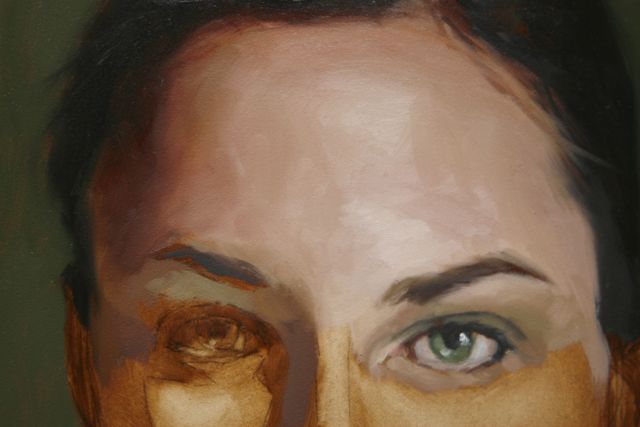This was the third session with my oil painting class working on this head study. If you're just now joining in, here is Part 1, and here is Part 2.
Before I began painting I did an oil out using a bit of Res-N-Gel, odorless mineral and linseed oil. This is acouching layer to restore the color to it's wet look and help the previous layer accept the new paint. I only oiled out the area previously painted.
It seems to be going slowly but I'm spending only about an hour demoing. Then the class has time to paint and I go from easel to easel answering questions. As I work I try to see in planes, modifying the color subtly as I go. I only worked on the section I thought I would get to that day, the forehead, hairline and eye.
 |
| Lyndsey, original reference |
On the positive side:
~The model doesn't move, the artist isn't shifting around so the view doesn't change
~The image is already flattened so there is no translation from 3-D to 2-D
~One can capture a momentary expression that a model cannot hold for hours.
~Model fees are less expensive
On the negative side:
~Because the image is already flattened the painting could look flat.
~If the original photography or print is inferior, there won't be good or accurate information to work from and the painting could be lacking.
~Working from a photo puts more distant between the artist and the model which some artists find less fulfilling. (Let's face it staring at a print or a computer monitor is not as fun as having a model to interact with)
However, there are things one can do to counteract the few negative aspects of working from photographs.
~Work from life as much as possible. It will help fill in the blanks so to speak when a photo is lacking. That life experience will come out in the paintings.
~Have long and fun photo shoots with the models. I find myself remembering our time together while I'm working on a painting. It's much like remembering an experience you've had when you hear a song or smell a certain scent. Enjoy those sessions and pay your models well as you will most likely get several paintings from each one.
~Paint people you know, then you can stare at them over dinner to figure out that extra little something that's missing in the photos. (My kids and husband love it when I do this)
~Watch people closely and pay attention to how light affects the color of skin, shines through ears and penetrates irises. (People might think you're a creeper but it really pays off in the studio)
~Have models come back in to model a part that needs clarification. (Or use another model, my husband has modeled the hands on several paintings including The Ascent)
~Invest in a good camera and learn how to take the best pictures possible.
~Use a software program like photoshop to help get the most out of the reference pictures.
Enjoy, see you for Part 4.


No hay comentarios:
Publicar un comentario